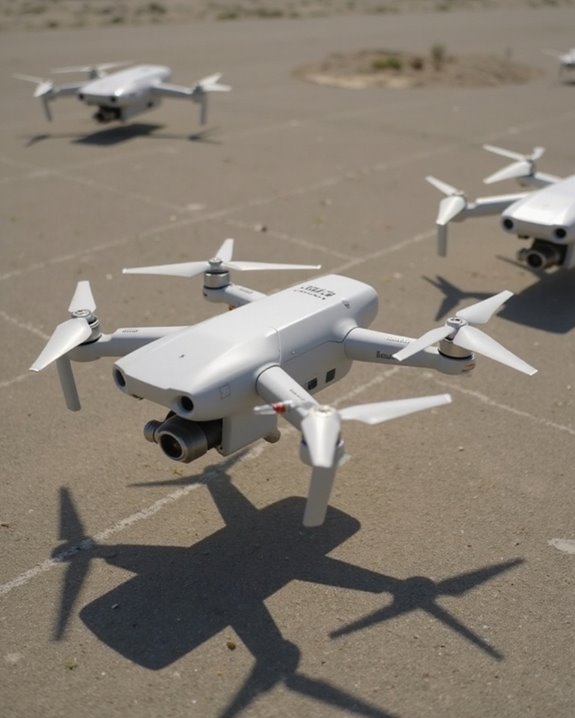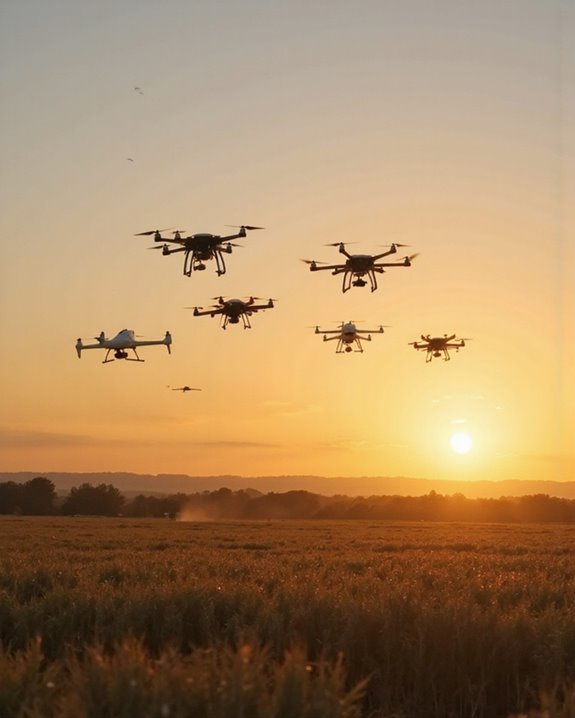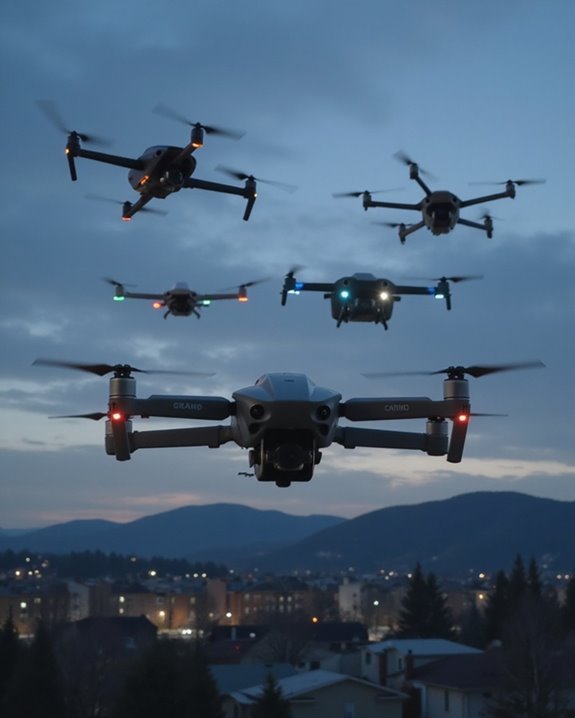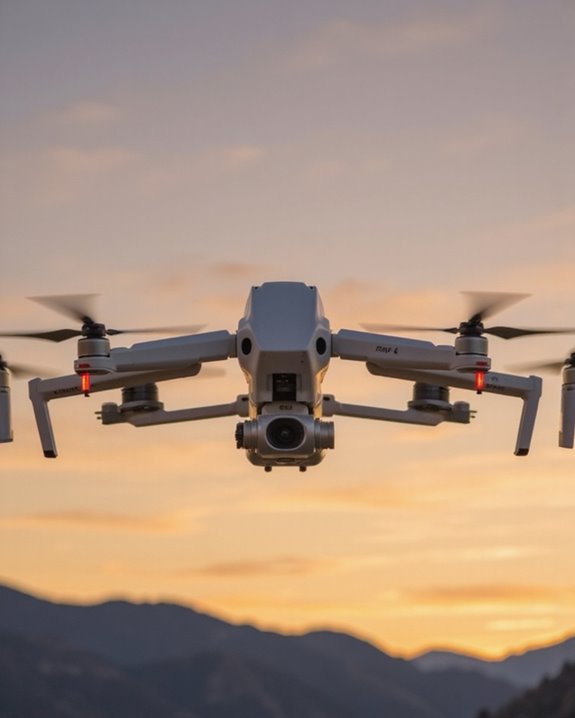Today’s top photogrammetry drones pack serious mapping muscle! The DJI Mavic 3 leads with its 20MP Hasselblad camera, while the Autel Evo II Pro impresses with 6K imaging. For budget-friendly options, check out the Holy Stone HS720G with its 75-minute flight time and GPS auto-return. You’ll want at least 30 minutes of flight time, 4K+ resolution, and reliable GPS for pro-level 3D modeling. Let’s explore which drone will turn your mapping dreams into reality!
Key Takeaways
- DJI Mavic 3 leads photogrammetry drones with its 20MP Hasselblad camera, 46-minute flight time, and exceptional 15km transmission range.
- Camera resolution of at least 20MP and flight times over 30 minutes are essential requirements for successful photogrammetry missions.
- GPS positioning accuracy and gimbal stabilization systems ensure precise, steady aerial shots necessary for creating accurate 3D models.
- The Autel Evo II Pro’s 6K camera with 1-inch CMOS sensor delivers professional-grade imagery ideal for detailed mapping projects.
- Software compatibility with mapping tools like Pix4D and DroneDeploy is crucial for processing drone imagery into usable 3D models.
Holy Stone GPS Drone HS175D with 4K Camera
- 4K Ultra Clear Camera: 4K camera with 110° wide-angle and 90° adjustable provides a high resolution picture, enable to capture a perfect shot; 5GHz FPV transmission...
- GPS Auto Return: GPS assisted flight, it can perform automatically return home when the drone lost signal, out of range or low power, never have to worry about flying it...
- Better Flight Experience: 2 batteries give you up to 46 minutes flight experience. And functions like Altitude Hold, Optical Flow, Headless Mode, One Key Take Off/Landing...
Photography enthusiasts looking for an entry-level drone will find the Holy Stone HS175D an impressive starting point for aerial photogrammetry! You’ll capture stunning aerial shots with its 4K camera featuring a 110° wide-angle lens and 90° adjustability, perfect for mapping projects.
With 46 minutes of total flight time using two batteries, you won’t need to rush your mapping sessions. The GPS-enabled features, including Auto Return and Follow Me mode, make navigation a breeze – even if you’re still mastering those pilot skills! While it’s not a professional-grade mapper, the HS175D’s stable hover and 1148-foot range make it an excellent choice for beginners who want to explore the world of aerial photography without breaking the bank.
Best For: Amateur photographers and mapping enthusiasts seeking an affordable entry-level drone with decent camera capabilities and GPS features to learn aerial photography basics.
Pros:
- Extended 46-minute flight time with two included batteries
- GPS-enabled features including Auto Return and Follow Me mode for easier navigation
- 4K camera with wide-angle lens and adjustable angle for versatile shooting
Cons:
- Known issues with SD card formatting and video recording interruptions
- Limited to beginner/intermediate level applications, not suitable for professional mapping
- Range of 1148 feet may be restrictive for more advanced aerial photography needs
4K GPS Drone with Dual Camera for Adults (UHD Remote Control)
- GPS Positioning Function: Drones with Camera 4K has GPS positioning, the drones can be one-key return, low power and out of control automatic return. Drones with optical...
- Easy to Use: Drone with camera has 6-channel with gyroscope, Up/down, forward/backward, left/right turn, left/right flying, all directions can be fine-tuned, stable and...
- Connected WIFI System Functions: Drones with cameras have photography, video and real-time image transmission, real time batterydisplay, brushless power, emergency stop,...
A powerful combination of GPS precision and dual cameras makes the Jardhom 4K drone an excellent choice for beginners diving into photogrammetry! You’ll love the 90° adjustable front lens with EIS anti-shake technology, making those mapping shots crisp and clear. With three batteries giving you 75 minutes of flight time, you won’t have to rush your survey work.
While it’s lightweight at just 1.6 ounces, this drone packs impressive features like optical flow mode and obstacle avoidance to keep your investment safe. The 5G connectivity guarantees real-time image transmission, and the intuitive remote controller with LCD display lets you monitor everything from battery life to camera angles – perfect for those “just one more pass” moments!
Best For: Entry-level drone enthusiasts and beginners interested in aerial photography and basic mapping who want GPS functionality and extended flight time without breaking the bank.
Pros:
- Long flight time with 3 batteries providing 75 minutes total
- Comprehensive safety features including GPS positioning, obstacle avoidance, and one-key return
- User-friendly features like 90° adjustable camera, real-time transmission, and LCD display controller
Cons:
- Relatively low customer rating (3.0 out of 5 stars)
- Very lightweight design (1.6 ounces) may struggle in windy conditions
- Limited resolution compared to professional-grade drones despite 4K label
Drone Photogrammetry Field Guide for Map Creation
- Calvo, Kike (Author)
- English (Publication Language)
- 72 Pages - 09/21/2015 (Publication Date) - Blurb (Publisher)
Drone enthusiasts seeking to create professional-grade maps will find tremendous value in having a thorough field guide that breaks down the fundamentals of photogrammetry. While you’ll discover plenty of free resources online, having a well-organized reference guide at your fingertips can streamline your learning curve – especially when you’re out in the field! Just don’t expect advanced techniques or cutting-edge software comparisons. The best field guides focus on core concepts like flight planning, point cloud generation, and orthomosaic creation, though you’ll want to supplement with online tutorials to stay current with evolving technology.
Best For: Drone beginners and hobbyists looking for a basic introduction to photogrammetry fundamentals and map creation in an organized, accessible format.
Pros:
- Provides a well-structured, easy-to-follow introduction to drone photogrammetry basics
- Convenient single-source reference guide for field use
- Clear explanations of core concepts like flight planning and orthomosaic creation
Cons:
- Contains numerous typing and grammatical errors
- Much of the information can be found for free online
- Lacks depth in software comparisons and advanced techniques
4K UHD GPS RC Drone with Camera for Adults (Smart FPV Quadcopter)
- 【Safety and After Sale Service】: ①Please watch the guide video on the guide page in the APP before flying and read the Manuals patiently to understand the...
- 【HD 5G FPV Camera】The GPS reduces the impact of shaking and jolts during flight on the shooting screen, and provides real-time correction for shake during drone video...
- 【Smart and Easy to Control】The GPS drone will automatically return to the take-off point when the battery is low, signal is weak, or the return button is pressed....
The CANKETEC Smart FPV Quadcopter makes an ideal entry point for aspiring aerial surveyors and mapping enthusiasts who don’t want to break the bank! With its 4K UHD camera, dual GPS-optical flow positioning, and impressive 30-minute total flight time from two batteries, you’ll have plenty of time to capture those essential mapping shots.
You’ll appreciate the drone’s stability features when collecting photogrammetry data, including altitude hold and one-key return. While it’s not quite DJI professional grade, the 5G WiFi transmission and brushless motors deliver smooth, reliable performance that’ll get your mapping projects off the ground – literally! Just remember to complete the outdoor calibration before your first photogrammetry mission.
Best For: Entry-level drone enthusiasts and hobbyists interested in basic aerial photography and mapping, but not recommended for professional surveying or commercial photogrammetry work.
Pros:
- Impressive 30-minute total flight time with two included batteries
- Comprehensive safety features including one-key return and low battery warning
- Good value with GPS positioning and 4K camera capabilities at an entry-level price point
Cons:
- Lower image quality compared to professional-grade drones (2K actual resolution despite 4K labeling)
- Limited customer review history with only 62 ratings
- Requires outdoor calibration before first use and may need frequent recalibration
OpenDroneMap: The Missing Guide (Second Edition)
- Toffanin, Piero (Author)
- English (Publication Language)
- 308 Pages - 06/18/2023 (Publication Date) - Independently published (Publisher)
Serious photogrammetry enthusiasts seeking in-depth guidance will find their perfect companion in “OpenDroneMap: The Missing Guide (Second Edition).” While online tutorials can leave you scratching your head, this thorough book dives deep into the powerful open-source software system, walking you through everything from ODM web nodes to the intricate workings of WebODM.
Be warned – this isn’t your basic beginner’s guide! You’ll need solid technical chops to navigate the setup process, but the payoff is worth it. The book excels at demystifying complex settings, helping you create stunning 3D models, and optimizing those tricky input parameters. Just keep in mind that if you’re running Windows without Docker, you’ll get access to full CPU power – a significant advantage over the Docker version’s half-capacity allocation!
Best For: Technical users and photogrammetry professionals who want comprehensive guidance on using OpenDroneMap and are comfortable with open-source software setup.
Pros:
- Provides detailed, systematic explanation of OpenDroneMap’s features and settings
- Offers in-depth guidance on creating 3D models from photographs
- Superior to online tutorials with comprehensive coverage of parameter optimization
Cons:
- Steep learning curve not suitable for beginners
- Command line chapter focuses mainly on Docker version
- Docker version limits CPU and memory usage to half capacity compared to non-Docker Windows version
Bwine F7 GPS Drone with 4K Camera and 3-Axis Gimbal
No products found.
Professional photographers seeking extended flight times will find their match in Bwine’s F7 GPS drone, a powerful performer that keeps you airborne for up to 75 minutes with its trio of 2600mAh batteries! You’ll capture stunning aerial imagery with its 4K camera mounted on a 3-axis gimbal, while the 120° FOV lens and larger CMOS sensor guarantee exceptional detail in every shot.
Need to map vast areas? The F7’s impressive 3000m control range and 2000m altitude capability have you covered. With FAA certification and built-in remote ID, you’re ready to fly legally right out of the box. Plus, advanced features like GPS auto-return and follow-me mode make complex photogrammetry missions a breeze!
Best For: Professional photographers and aerial mapping specialists who need extended flight times and high-quality 4K imagery with advanced GPS features.
Pros:
- Exceptional 75-minute flight time with three included batteries
- Professional-grade 4K camera with 3-axis gimbal stabilization
- Comprehensive safety features including GPS auto-return and FAA certification
Cons:
- Long battery charging time (6-7 hours)
- High-end price point (implied by professional features)
- Requires significant storage space for 4K footage
Holy Stone GPS Drone with 4K UHD Camera (HS360S)
- Extremely Lightweight, No FAA or Remote ID Registration: HS360S, drone with camera for adults featuring the Holy Stone latest design, weighs less than 250g; this GPS...
- 4K UHD Camera with GalaxyCore Sensor: Holy Stone drones with camera for adults 4K equipped with 1/3'' CMOS GalaxyCore Sensor and 4K 85° wide-angle Camera adjusted within...
- Advanced Connection Technology: HS360S, a GPS drone with camera, features Holy Stone's enhanced remote controller. Now you can connect your smartphone to the controller...
Lightweight and registration-free, Holy Stone’s HS360S represents an ideal entry point for aspiring aerial mappers and photogrammetry enthusiasts who don’t want the hassle of FAA paperwork. You’ll appreciate the 4K UHD camera with its Galaxy Core Sensor and versatile 85-90° adjustable angle, perfect for capturing detailed terrain data and structural mapping.
The drone’s robust GPS positioning and optical flow systems keep it remarkably stable during mapping missions, while the impressive 10,000-foot control range lets you tackle larger sites. With intelligent flight modes like Waypoint Flight and Point of Interest, you’ll quickly master the basics of aerial surveying – and those 20-minute flight times mean you won’t have to rush your mapping runs!
Best For: Entry-level drone enthusiasts and hobbyist aerial photographers seeking a lightweight, registration-free drone with good camera capabilities and GPS features.
Pros:
- Lightweight design under 250g eliminates need for FAA registration
- Impressive 10,000-foot control range with stable GPS positioning
- 4K UHD camera with adjustable angle and multiple intelligent flight modes
Cons:
- 20-minute flight time may be limiting for longer mapping missions
- Limited camera sensor size may affect image quality in low light
- 85-90° adjustable angle range is relatively narrow compared to professional drones
Holy Stone GPS Drone with 4K Camera (HS360S)
- Extremely Lightweight, No FAA or Remote ID Registration: HS360S, drone with camera for adults featuring the Holy Stone latest design, weighs less than 250g; this GPS...
- 4K UHD Camera with GalaxyCore Sensor: Holy Stone drones with camera for adults 4K equipped with 1/3'' CMOS GalaxyCore Sensor and 4K 85° wide-angle Camera adjusted within...
- Advanced Connection Technology: HS360S, a GPS drone with camera, features Holy Stone's enhanced remote controller. Now you can connect your smartphone to the controller...
The Holy Stone HS360S makes photogrammetry accessible to drone enthusiasts who don’t want the hassle of FAA registration, since it weighs under 250g. You’ll appreciate its 4K UHD camera with GalaxyCore Sensor that captures crisp aerial images, while the 85° wide-angle lens (adjustable to 90°) gives you plenty of coverage for mapping projects.
The drone’s 5G transmission and impressive 10,000-foot control range let you tackle larger mapping areas, and with 20 minutes of flight time, you won’t feel rushed! Smart features like GPS positioning, Follow Me mode, and Waypoint Flight make capturing consistent mapping data a breeze – perfect for when you’re ready to graduate from casual flying to serious photogrammetry work.
Best For: Beginner drone enthusiasts interested in aerial photography and basic mapping who want a lightweight, registration-free drone with advanced features.
Pros:
- Lightweight design under 250g eliminates need for FAA registration
- Advanced features like GPS positioning and intelligent flight modes make it user-friendly
- Strong transmission range and decent flight time for its size class
Cons:
- Camera sensor size may limit image quality in challenging lighting conditions
- 20-minute flight time might be insufficient for larger mapping projects
- Limited lens adjustment range compared to professional mapping drones
Remote Pilot Test Prep 2021 Study Guide for Part 107 Test
- ASA Test Prep Board (Author)
- English (Publication Language)
- 144 Pages - 11/17/2020 (Publication Date) - Aviation Supplies & Academics, Inc. (Publisher)
Aspiring drone pilots will find exceptional value in this thorough Part 107 test preparation guide, which has helped users achieve impressive scores ranging from 88% to 98% on their first attempts! With over 340 practice questions and 5 online tests, you’ll get plenty of hands-on preparation that closely mirrors the actual exam.
The guide bundles the essential Airman Knowledge Testing Supplement and provides access to crucial charts and figures you’ll need. While the 2021 edition doesn’t cover the latest FAA regulations about night flying and operations over people, you can easily supplement your studying with online research – and for $18, it’s a steal compared to pricey courses!
Best For: Aspiring drone pilots seeking an affordable, comprehensive study guide to pass the Part 107 Remote Pilot exam on their first attempt.
Pros:
- Extensive practice material with 340+ questions and 5 full online tests that closely match the actual exam format
- Includes essential Airman Knowledge Testing Supplement with required charts and figures
- Proven track record of helping users achieve high passing scores (88-98%) at a fraction of the cost of expensive courses
Cons:
- 2021 edition lacks updates on latest FAA regulations regarding night flying and operations over people
- Limited to only 5 practice test attempts without purchasing additional codes
- Requires supplemental online research to cover new regulatory topics not included in the guide
Sky High Bulls-Eye Drone Ground Control Point GCP (6 Pack)
- 48”x48” AERIAL TARGETS - Designed for low to medium altitude drone mapping and scanning, these drone GCPs were made for drone mapping up to 400 feet. The standard...
- DRONE GCP WITH CENTER PASSTHROUGH - The center passthrough design allows pre-established survey stakes or survey markers to be slid directly through the GCP for added...
- LIGHTWEIGHT & DURABLE AERIAL TARGETS - Using a weatherproof mesh material, these GCPs were made to be highly visible yet lightweight, a big benefit when traveling or...
Professional surveyors and mapping specialists will appreciate these highly visible 48×48 aerial targets, designed specifically for precise photogrammetry work! These durable black-and-white mesh markers feature convenient center pass-through points and corner eyelets, making them perfect for accurate ground control placement.
You’ll love how easily these GCPs show up in your aerial imagery from 20 to 400 feet, thanks to their matte finish that prevents sunlight glare. They’re compatible with popular software like Pix4D and DroneDeploy, and they’re so lightweight you won’t break a sweat carrying them around (unlike those clunky topographic poles)! The weatherproof construction guarantees reliable, repeatable data collection across multiple flights – exactly what you need for professional mapping projects.
Best For: Professional surveyors, drone operators, and mapping specialists who need reliable ground control points for accurate aerial photogrammetry and mapping projects.
Pros:
- Highly visible from 20-400 feet with matte finish that reduces glare
- Lightweight, portable design with weatherproof construction for repeated use
- Compatible with popular mapping software like Pix4D and DroneDeploy
Cons:
- May require additional anchoring in windy conditions
- Limited to black and white markings (no color options available)
- 48×48 size might be too large for some compact storage/transport situations
Factors to Consider When Choosing Drone Photogrammetry
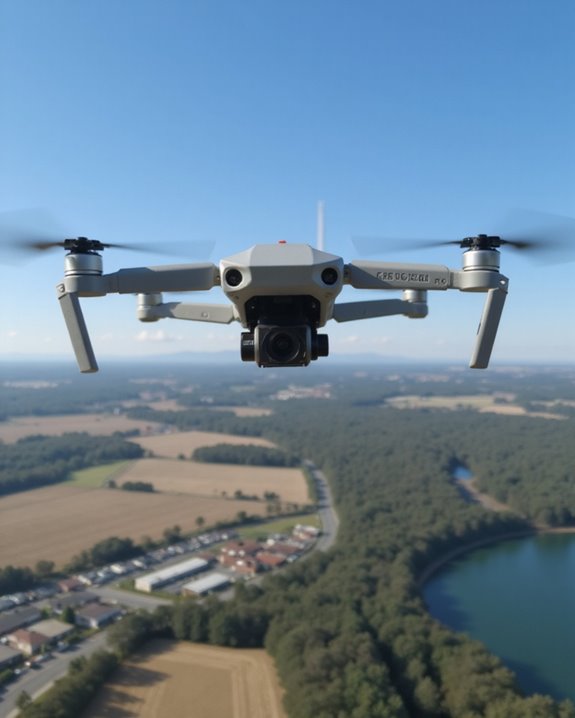
When you’re ready to choose a drone for photogrammetry, several key factors will determine your mapping success! You’ll need to carefully evaluate specs like camera resolution (aim for at least 20MP), flight endurance (30+ minutes is ideal), and GPS positioning accuracy – these work together like a well-oiled machine to deliver those crisp, precisely-aligned aerial shots. Beyond the hardware basics, you’ll want to confirm your drone’s compatibility with industry-standard photogrammetry software and make sure it has a robust gimbal system that keeps your camera steady as a surgeon’s hand, even when the wind picks up.
Camera Resolution and Quality
How important is camera quality when it comes to drone photogrammetry? It’s absolutely critical – you’ll need high-quality resolution and clarity to create accurate 3D models and maps!
Your drone’s camera should pack a serious punch with 4K resolution (that’s 3840×2160 pixels), which lets you capture those tiny details that make all the difference in your surveys. You’ll want a CMOS sensor that performs like a champ in various lighting conditions – because let’s face it, the sun doesn’t always cooperate with your flight schedule! Look for a wide field of view between 85° and 120° to maximize your coverage area, and don’t forget about that all-important gimbal stabilization. Trust us, nothing ruins a mapping project faster than blurry images! Make sure your camera supports industry-standard formats like JPEG and MP4 for hassle-free processing.
Flight Time and Range
Even with the best camera setup, your drone’s flight capabilities will make or break your photogrammetry success! You’ll want to carefully consider both flight time and range when selecting your perfect mapping companion.
Today’s top performers can stay airborne for up to 75 minutes using multiple batteries, which means you won’t be running back and forth for constant recharges. While basic models might only give you 20-46 minutes per battery (talk about a quick coffee break!), advanced drones can reach impressive distances of over 3,000 meters. That’s a lot of ground to cover!
For those tackling larger sites, look for drones with operational ranges exceeding 10,000 feet. Remember, the perfect combination of endurance and reach will help you capture every nook and cranny of your mapping site without missing a spot.
GPS Positioning Accuracy
Pinpoint GPS accuracy serves as the backbone of successful drone photogrammetry, transforming your aerial shots into precise, usable data! You’ll want to look for drones equipped with high-precision GPS systems that can achieve sub-meter accuracy – because nobody wants their mapping project to be off by the length of a soccer field!
For professional-grade results, you’ll need positioning accuracy better than 1 meter, especially when creating detailed orthomosaics. Look for drones with differential GPS capabilities and those that can track multiple satellites simultaneously. Remember, even the best GPS systems can be thrown off by tall buildings or dense tree cover, so you’ll want robust positioning technology that can maintain accuracy in challenging conditions. The good news? Today’s top mapping drones pack impressive GPS tech that’ll keep your data right where it belongs!
Software Compatibility Options
The right software compatibility can make or break your drone photogrammetry workflow! When you’re choosing software for your mapping projects, you’ll want to make sure it plays nicely with your operating system – whether you’re team Windows, macOS, or Linux.
Look for programs that handle common drone image formats like JPEG and MP4 without throwing a fit. You’ll also need to check those pesky system requirements – nothing’s worse than watching your computer crawl through processing because you’re short on RAM! For the data wizards out there, consider software that connects smoothly with your favorite GIS platforms. And here’s a pro tip: don’t overlook open-source options! They might lack the fancy packaging of commercial software, but they’ll give you amazing flexibility and access to a helpful community of fellow mappers.
Gimbal Stabilization System
Solid image stabilization serves as the backbone of successful drone photogrammetry, and that’s where a quality gimbal system comes into play! When you’re mapping terrain or creating 3D models, you’ll want a drone equipped with a three-axis gimbal that handles pitch, roll, and yaw movements like a pro.
Think of your gimbal as your drone’s steady hand – it’s constantly working to keep your camera level and shake-free, even when the wind tries to play havoc with your flight! The best systems feature electronic stabilization that automatically adjusts to environmental challenges, saving you countless hours of post-processing headaches. You’ll especially appreciate the motorized precision when you’re capturing those tricky oblique angles or maintaining consistent overlap between images. Trust us, a reliable gimbal system is worth its weight in perfectly aligned photos!
Ground Control Points
Accurate photogrammetry mapping depends heavily on well-placed ground control points, those essential markers that’ll transform your aerial shots into precision-perfect data! Think of them as your drone’s trusted reference points, helping you create maps that are spot-on every single time.
You’ll want to choose ground control points with high-contrast patterns (black and white is your best friend here) that are visible from up to 400 feet. Don’t forget about durability – your markers should be weatherproof and easy to transport across rough terrain. Pro tip: look for designs with built-in anchor points or eyelets to keep them from playing hide-and-seek with the wind! When you’re setting up your points, remember that proper placement is key to getting those super-accurate distance measurements in your photogrammetry software.
Battery Life Management
While ground control points keep your mapping accurate, mastering battery life management can make or break your photogrammetry mission! You’ll need to plan carefully, as typical flight times range from 20 to 75 minutes per battery, depending on your drone’s capacity.
Here’s a pro tip: always pack multiple batteries! With three fully charged batteries in your kit, you’re looking at up to 75 minutes of total flight time – perfect for those larger survey projects. But don’t forget that pesky wind resistance and altitude changes can drain your power faster than expected. Since charging takes 6-7 hours with standard 5V chargers, you’ll want to prep your batteries the night before. Trust me, there’s nothing worse than having to cut your mapping short because you didn’t plan your power strategy!
Automated Flight Modes
The advanced automated flight modes in today’s photogrammetry drones are a total game-changer for aerial mapping! You’ll love how these smart systems take care of the tedious work, letting you focus on capturing perfect data sets while reducing human error by up to 50%.
Your drone will expertly maintain that essential 60-80% forward overlap and 30-60% side overlap – no more squinting at the screen hoping you’ve got it right! With GPS-guided precision down to centimeters, you’re getting professional-grade accuracy without breaking a sweat. The best part? These automated systems watch your back with return-to-home features, so there’s no need to panic if your signal drops mid-flight. Plus, they’re smart enough to optimize flight paths for maximum battery efficiency, letting you cover more ground in a single mission. Who knew robots could be such reliable photography assistants?
Frequently Asked Questions
What Insurance Coverage Do I Need for Commercial Drone Photogrammetry Work?
You’ll need extensive commercial drone insurance that includes both liability and hull coverage. Essential policies should cover bodily injury/property damage ($1-2M minimum), professional liability for mapping errors, and equipment protection for your drone. Don’t forget to add payload coverage for your cameras and sensors! Many providers like SkyWatch.AI and DroneInsurance.com offer flexible, pay-as-you-fly options that’ll keep you fully compliant with FAA requirements and client expectations.
How Often Should Drone Batteries Be Replaced for Optimal Mapping Performance?
“Better safe than sorry” is especially true when it comes to your drone batteries! You’ll want to replace them after 150-200 charging cycles or when you notice a 20% drop in flight time, whichever comes first. Keep track of your batteries’ performance using a logbook, and you’ll start noticing the signs – shorter flights, longer charging times, or swelling. For professional mapping work, don’t push your luck – replace them every 12-18 months!
Can Photogrammetry Drones Be Used Effectively in Windy or Cloudy Conditions?
Yes, you can fly photogrammetry drones in less-than-perfect conditions, but you’ll need to be smart about it! For wind, stick to speeds under 15-20 mph to maintain stable flight paths and sharp imagery. Cloudy conditions actually work in your favor – they provide even lighting and reduce harsh shadows. Just avoid rainy days (your drone won’t appreciate the shower!) and make sure there’s enough light for your camera to capture clear, detailed shots.
What Software Compatibility Issues Might Arise With Different Drone Mapping Systems?
You’ll want to watch out for those pesky software compatibility headaches! Common issues include DJI drones not playing nicely with non-DJI processing software, and data format conflicts between different mapping platforms. Your best bet is to verify that your drone’s output format matches your preferred software – whether you’re using Pix4D, DroneDeploy, or Agisoft Metashape. Consider checking SDK (Software Development Kit) compatibility before making any big purchases.
Are Special Permits Required for Drone Photogrammetry in Residential Areas?
Just like how your great-grandpa needed a permit to park his Model T, you’ll definitely need proper authorization for drone photogrammetry in residential zones! You must obtain both a Part 107 commercial drone license from the FAA and local permits from your city or county. Don’t forget to check airspace restrictions, especially if you’re within 5 miles of an airport. Also, you’ll need written permission from property owners when flying over private residences.

